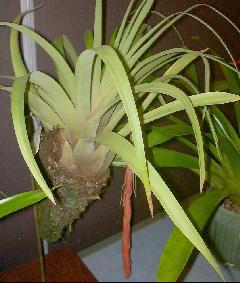
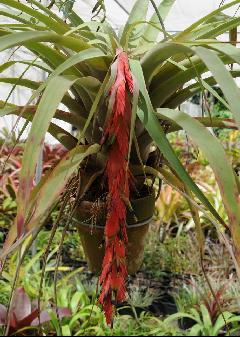
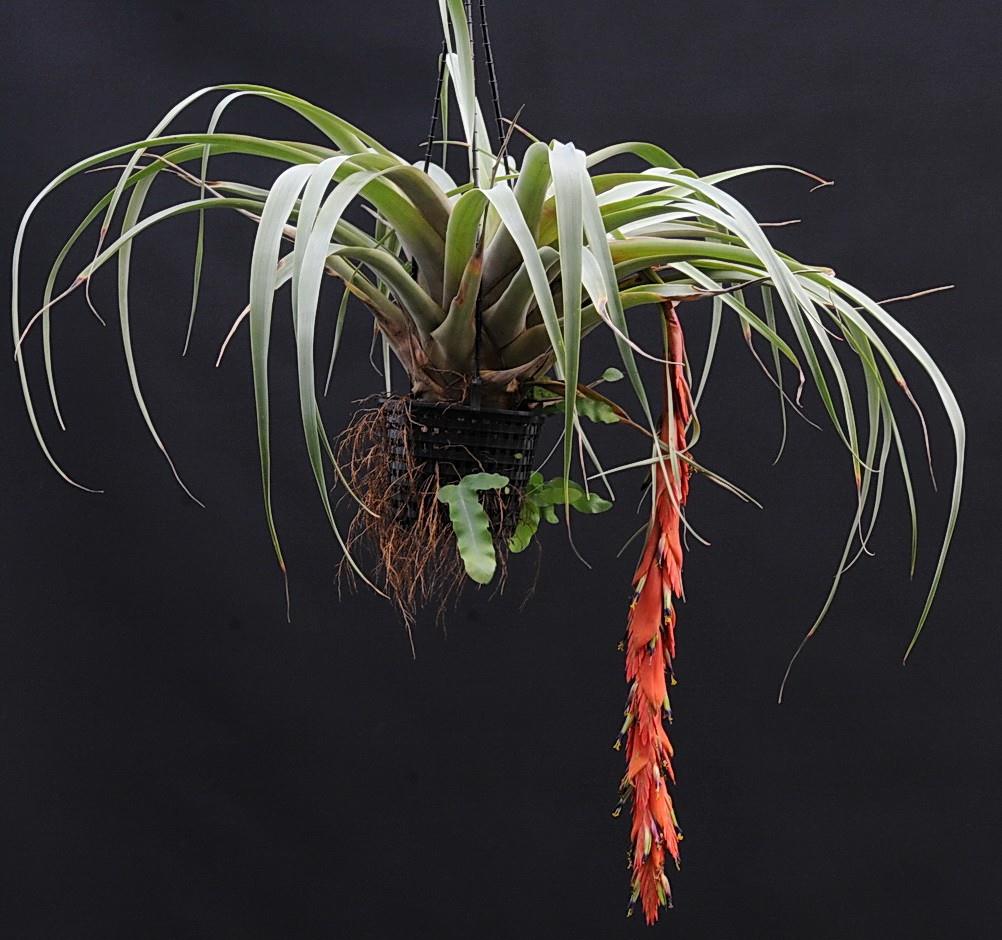
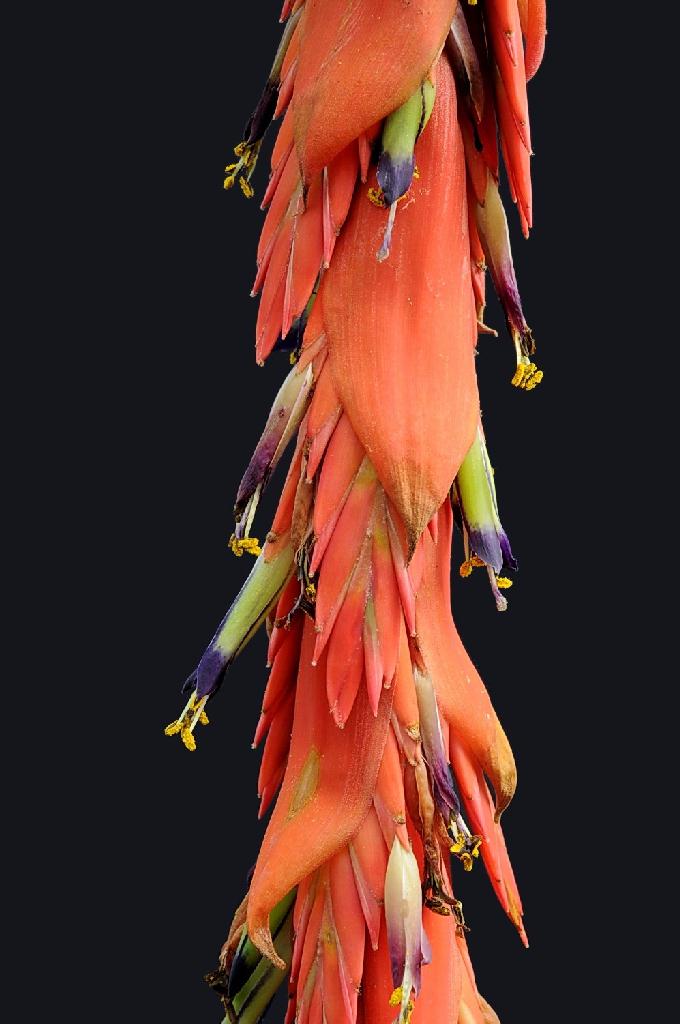
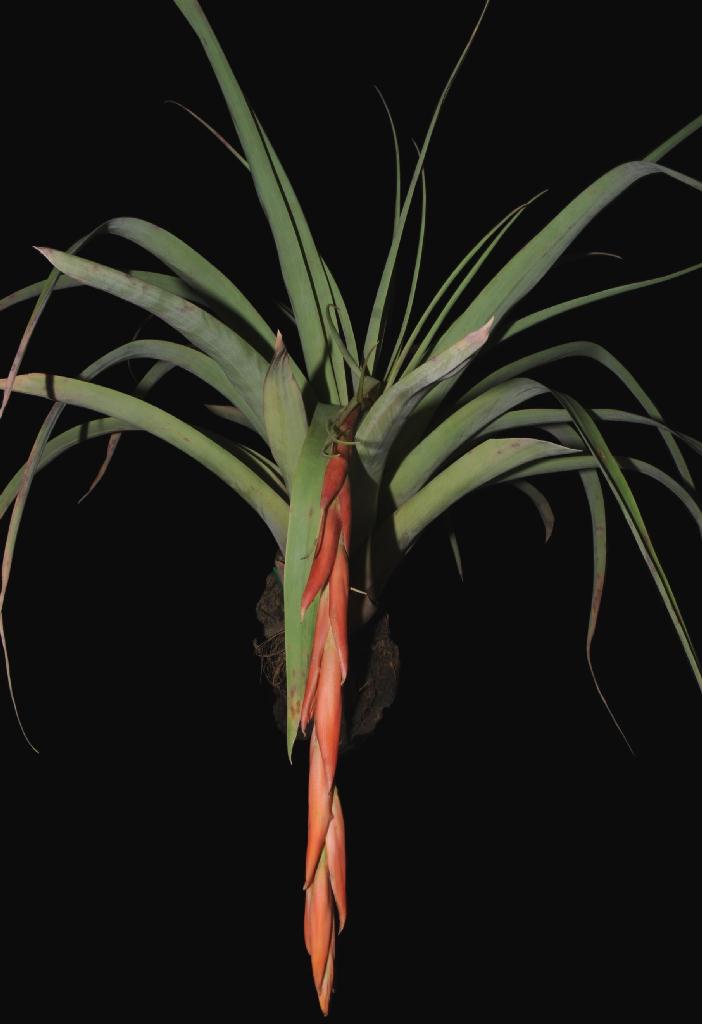
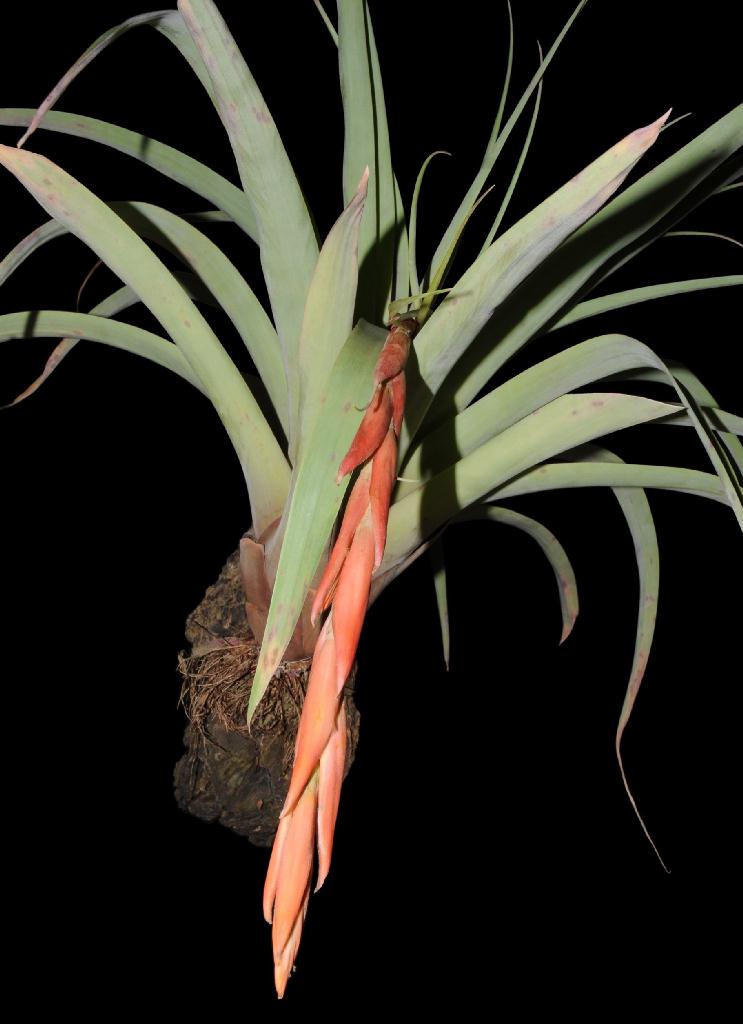
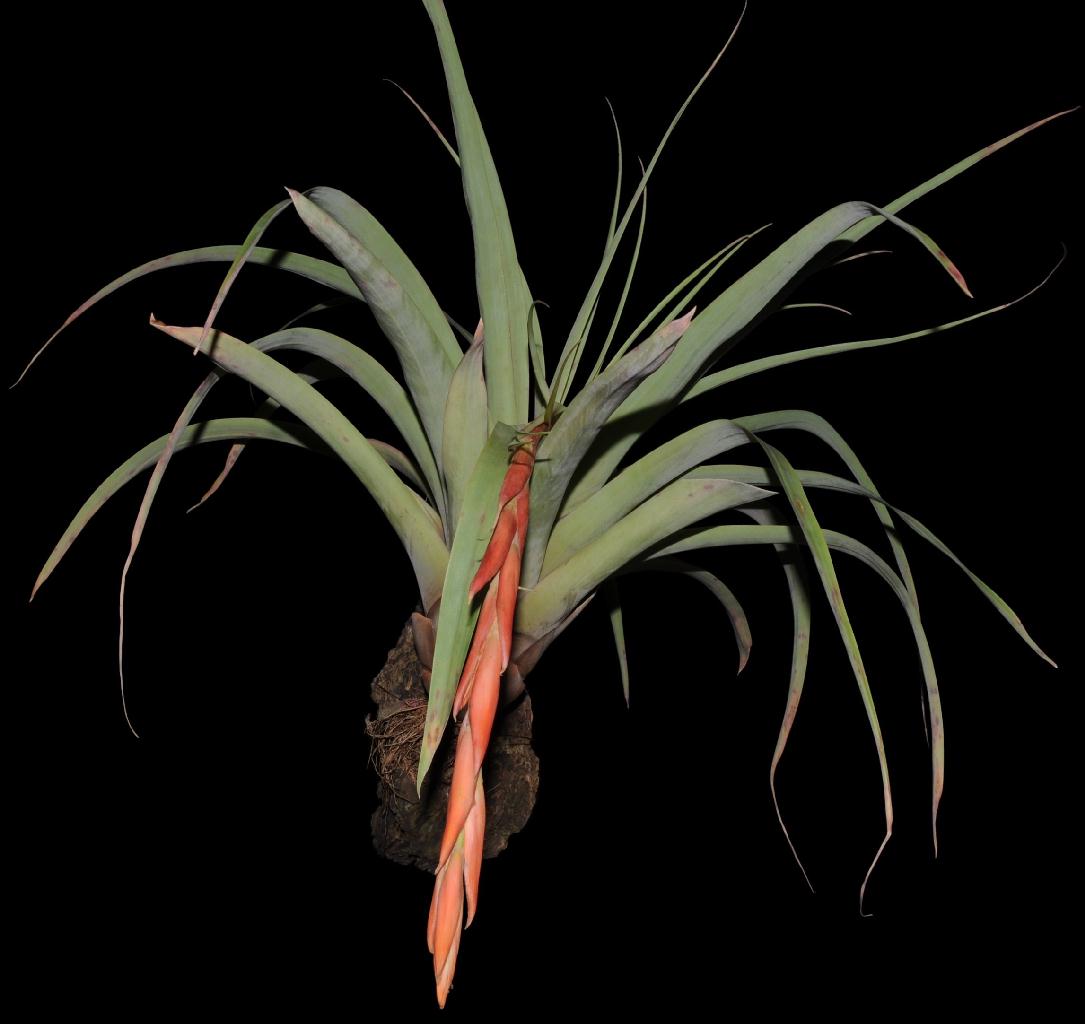
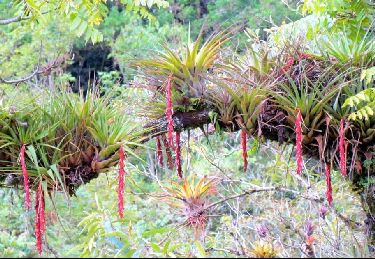
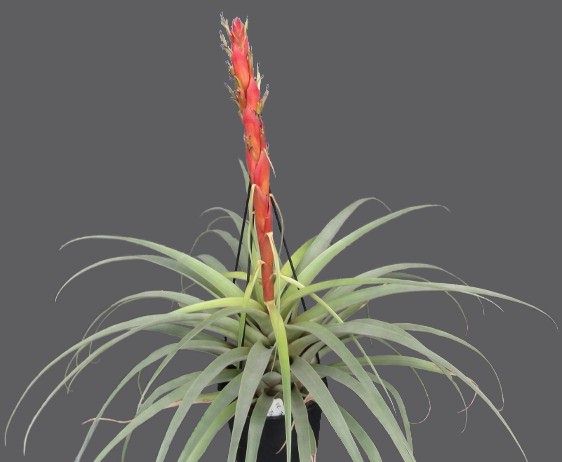
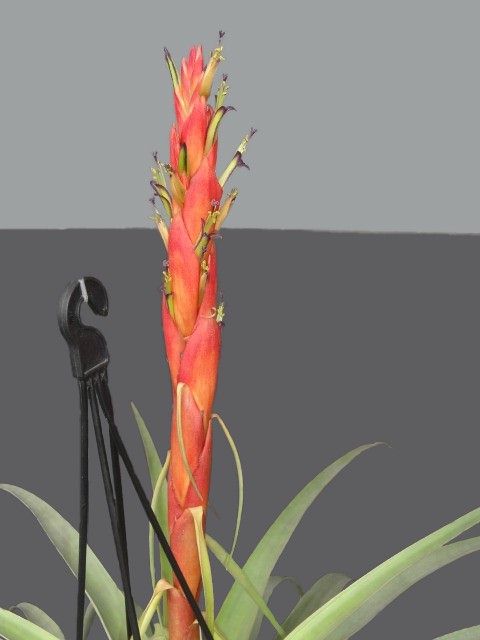
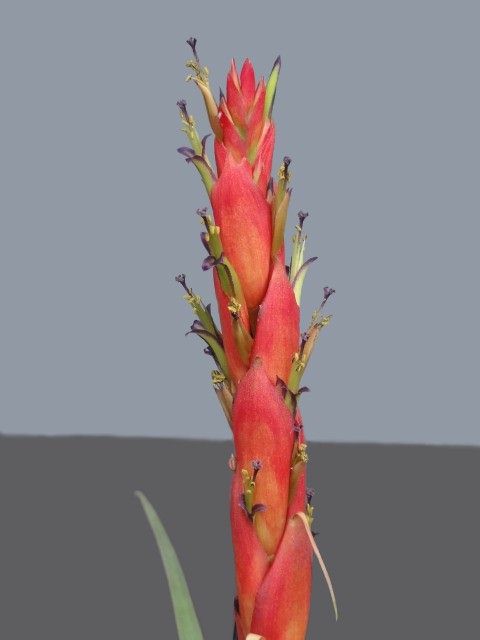
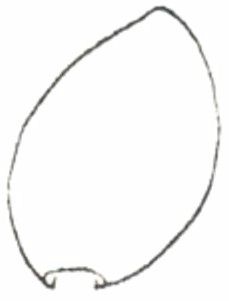
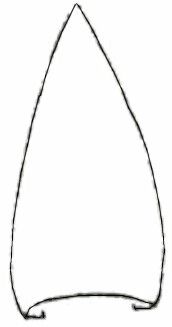
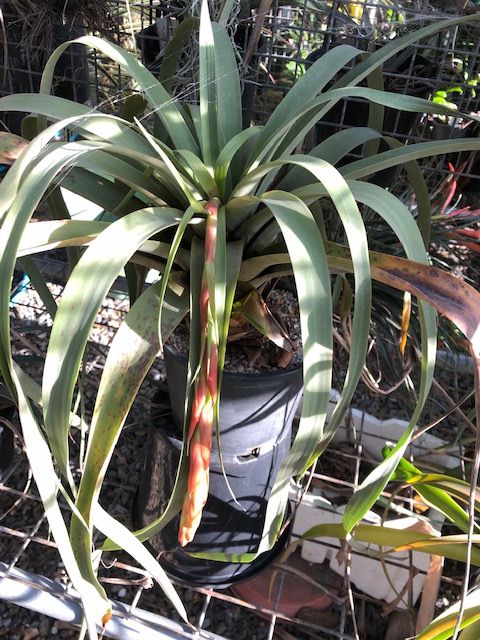
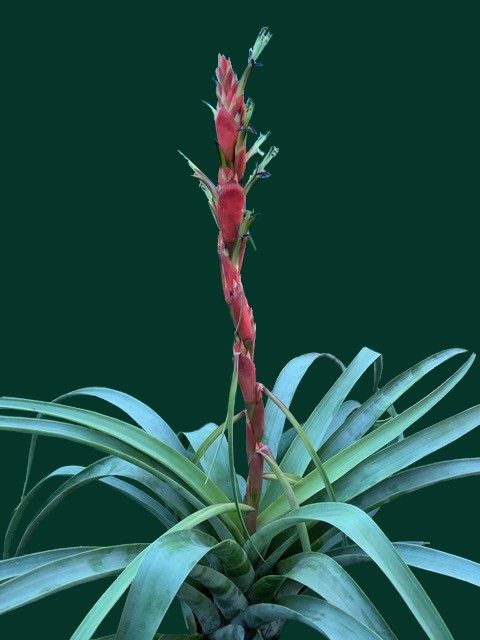
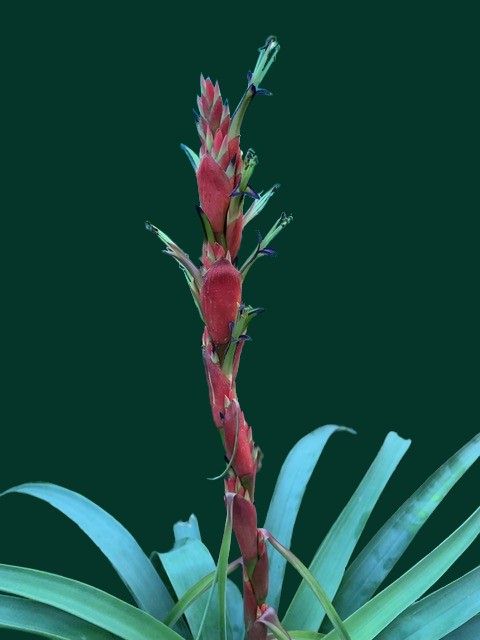
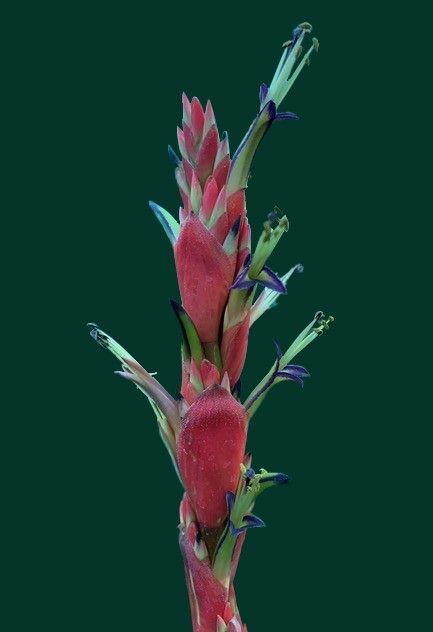
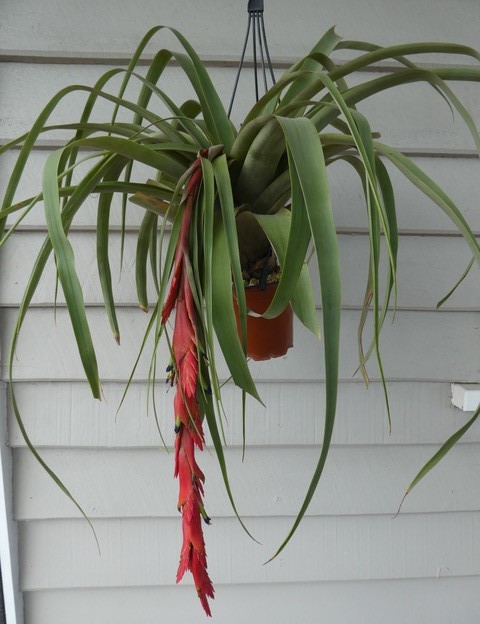
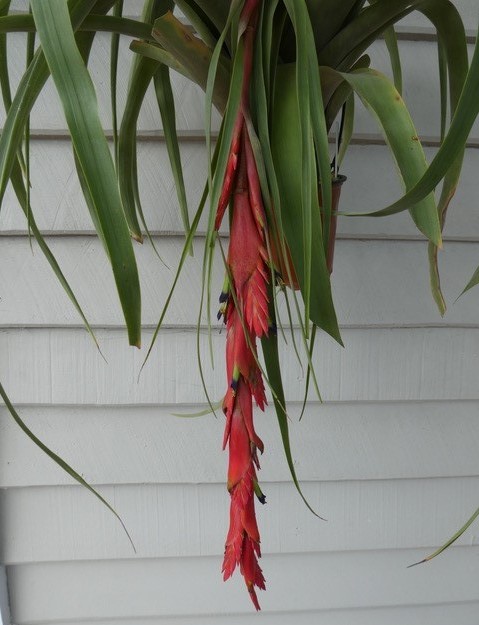
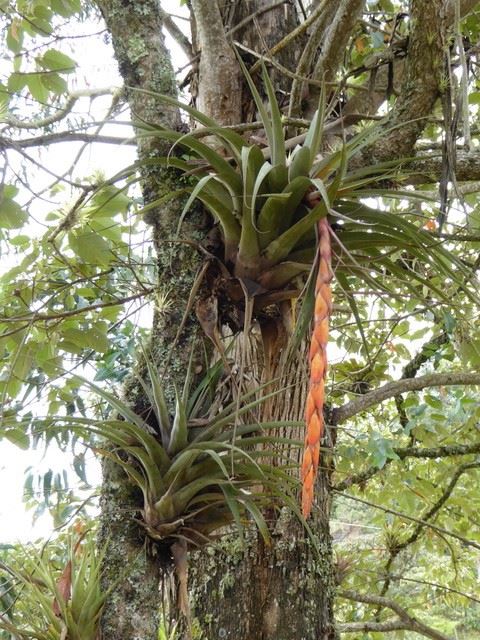
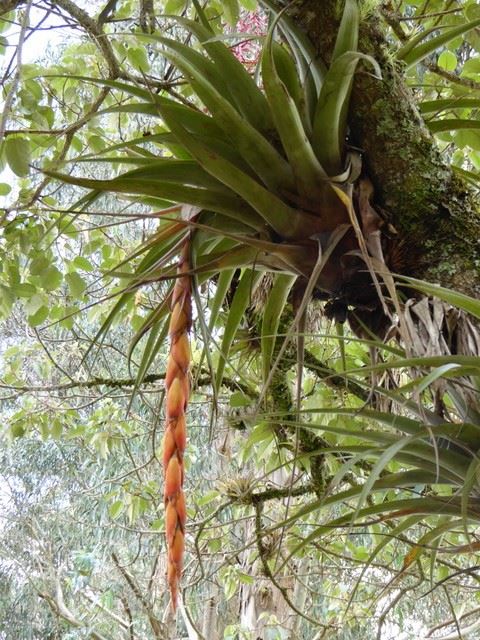
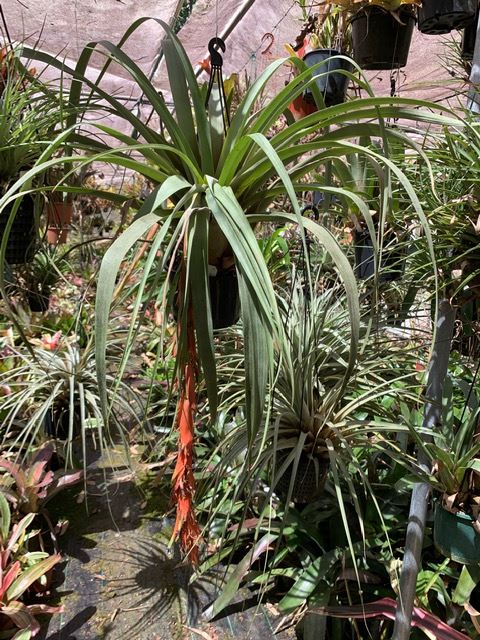
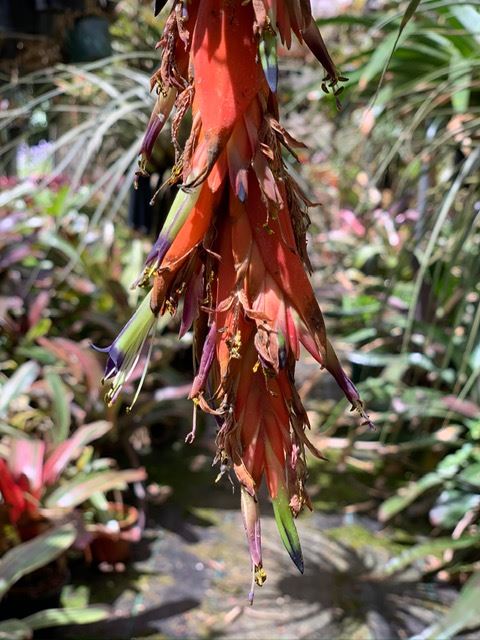
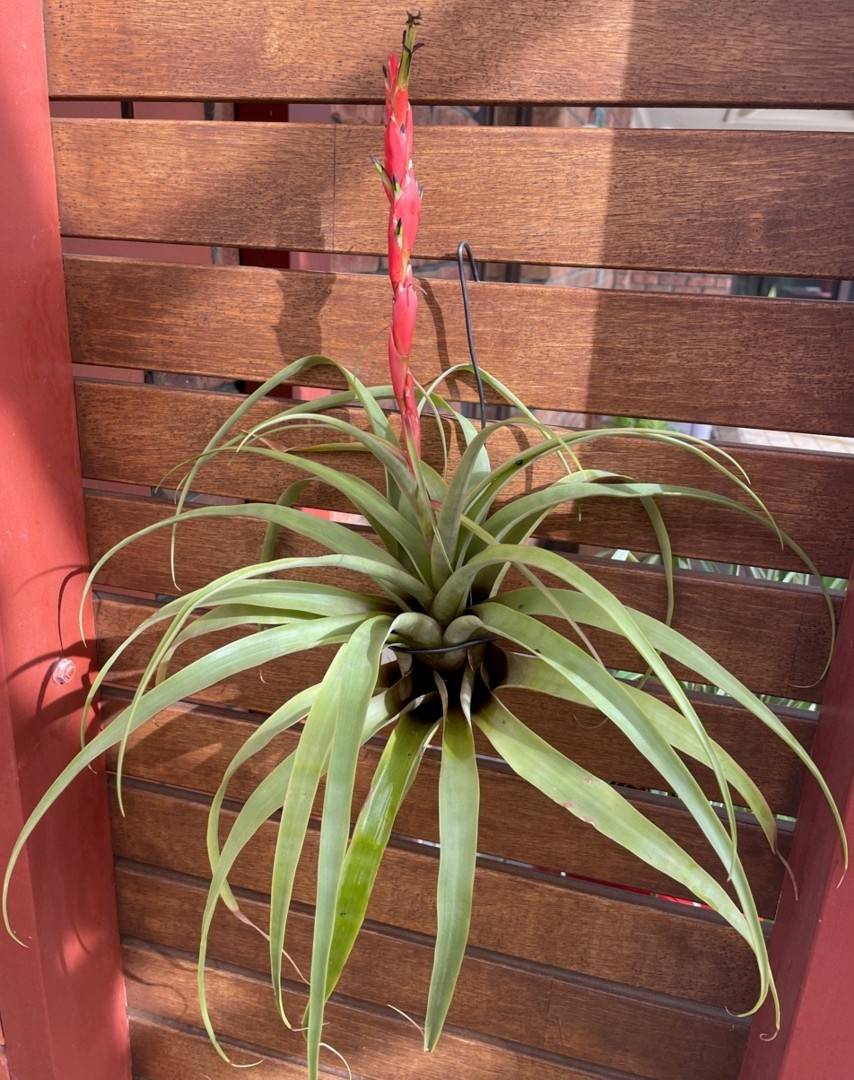
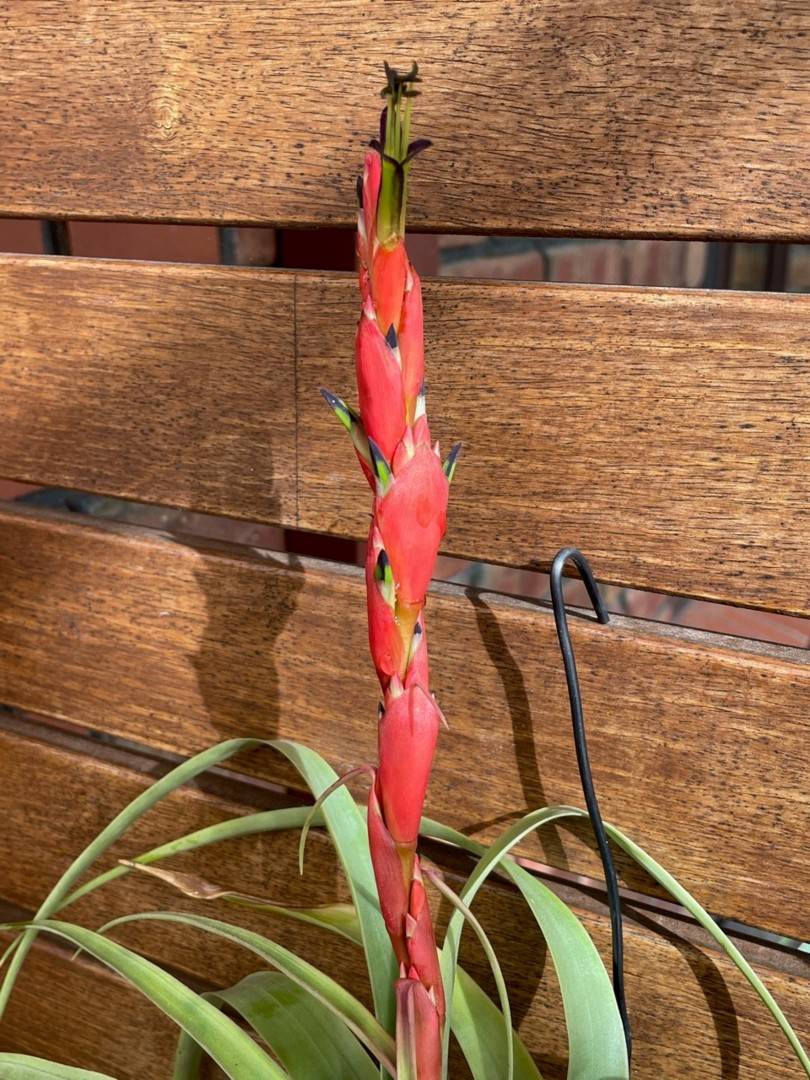
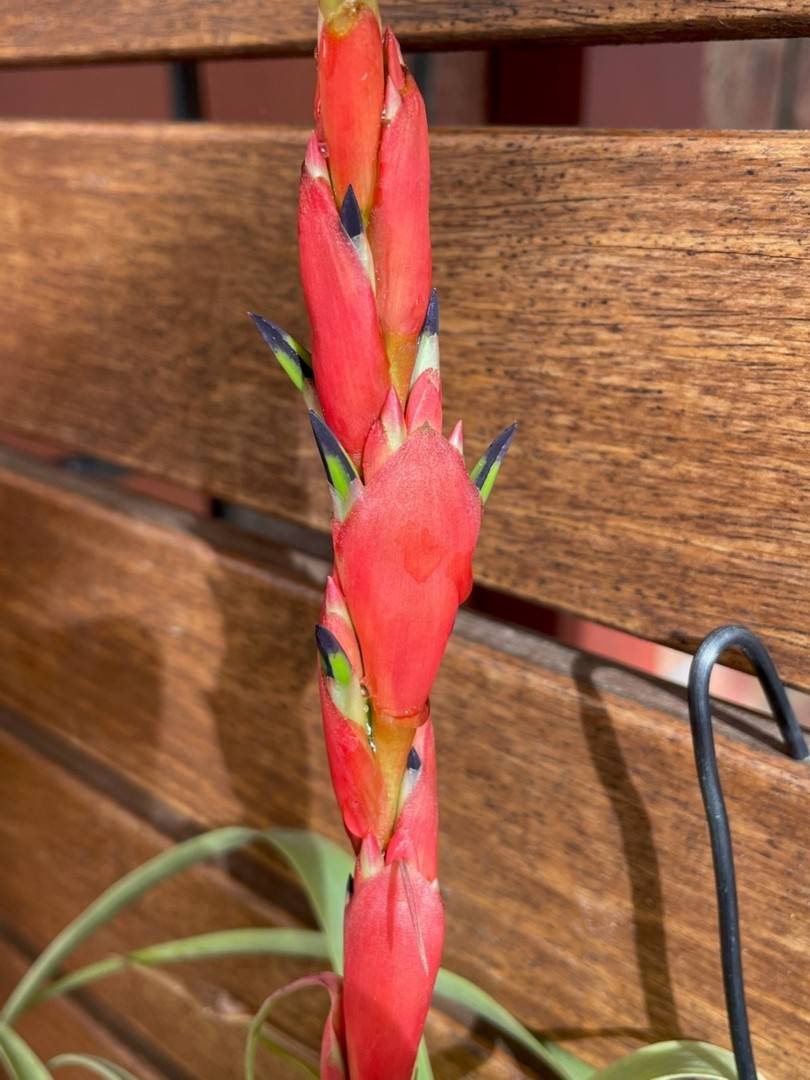
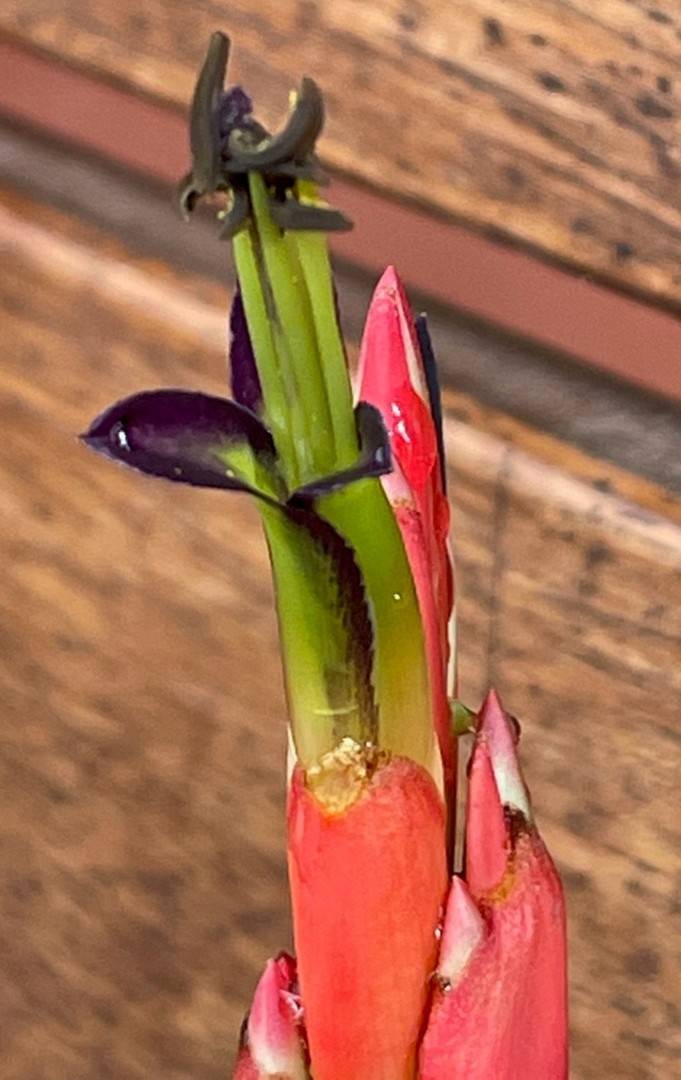
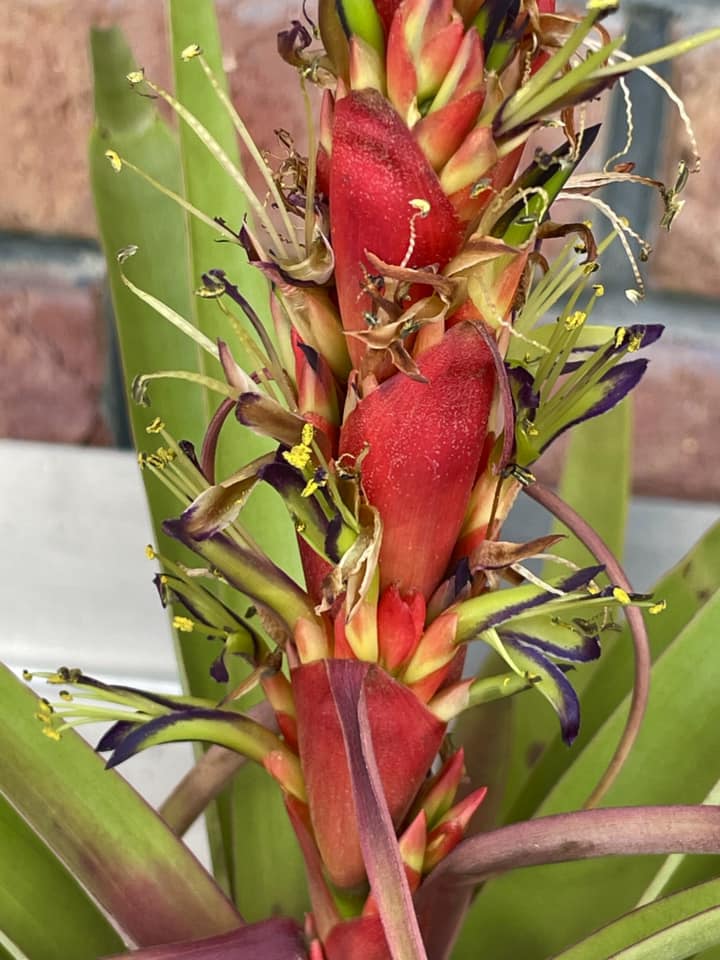
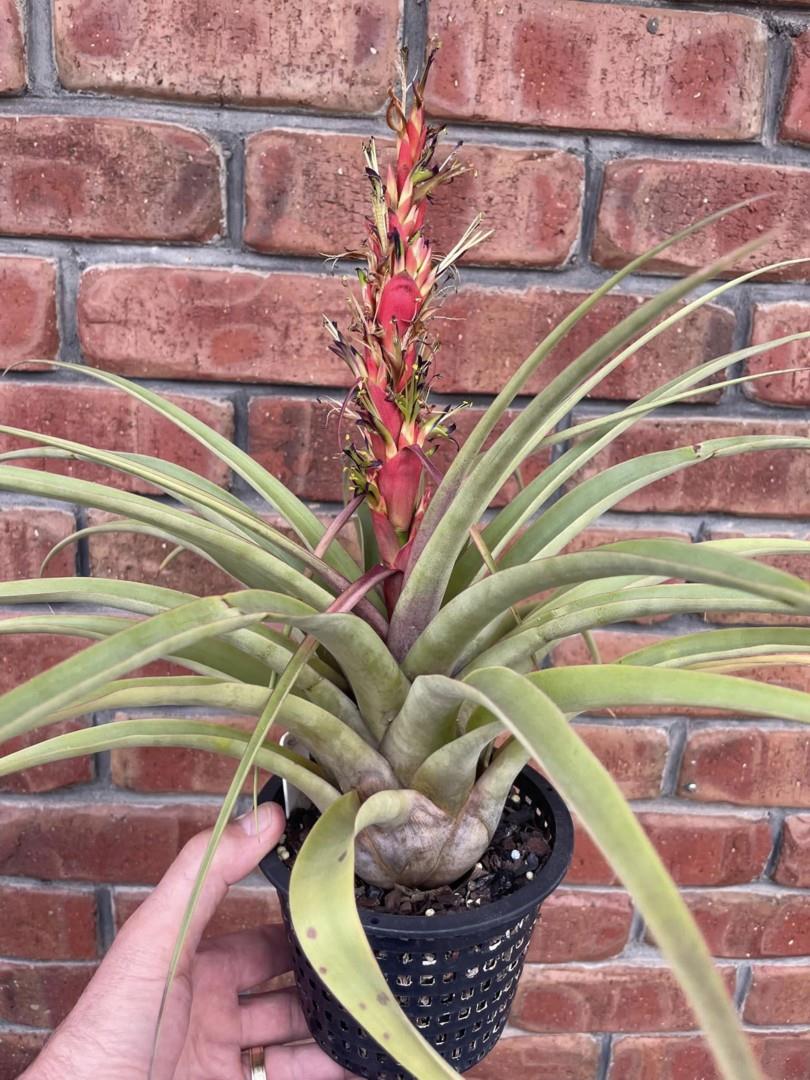
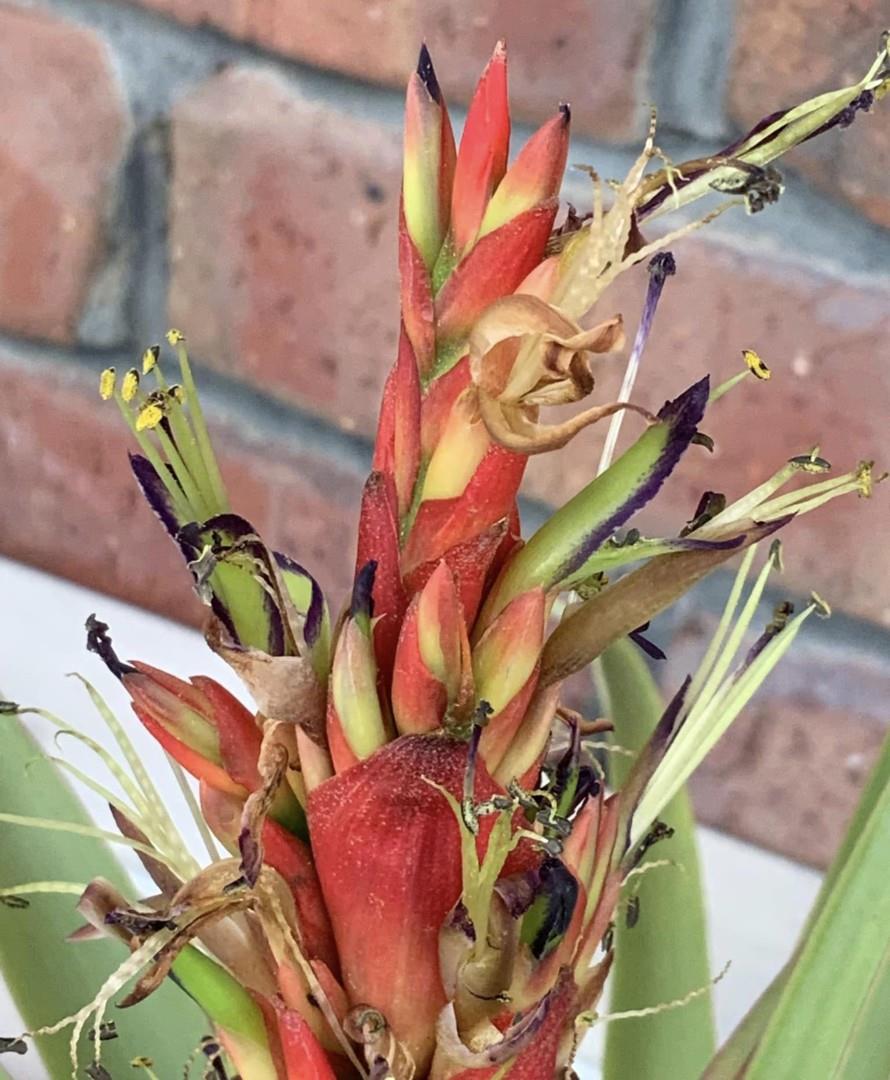
Desc from S&D p1255-6
Plant stemless, flowering 7-8 dm high.
Leaves 5-6 dm long, densely cinereous-lepidote;
Sheaths broadly ovate, to 17 cm long, dark castaneous;
Blades very narrowly triangular, 4-7 cm wide at base.
Scape decurved, stout;
Scape-bracts densely imbricate, slenderly laminate.
Inflorescence densely bipinnate, slenderly cylindric, 2-4 dm long;
Primary bracts like the scape-bracts but the upper ones bladeless, the lower imbricate and largely covering the spikes, orange, densely lepidote at apex;
Spikes sessile, lanceolate, 4-7 cm long, complanate, 6-10-flowered;
Rhachis broadly alate.
Floral bracts densely imbricate, ovate, acute, 22 mm long, equaling or shorter than the sepals, carinate, coriaceous, even, glabrous, orange;
Flowers subsessile.
Sepals elliptic, acute, to 20 mm long, ecarinate, even, glabrous;
Petals linear, 4 cm long, green with blue margins, bearing 2 linear largely adnate scales; Stamens exserted.
Type. Andre 1355 (holotype K, GH photo), Falls of Tequendama, Cundinamarca, Colombia, Feb 1876.
DISTRIBUTION. Saxicolous and epiphytic in woods, 1200-3100 m alt, Colombia, Venezuela, Ecuador and Peru.
COLOMBIA. MAGDALENA: Pueblo Bello, Sierra Nevada de Santa Marta, 16 Aug 1946, Foster & Smith 1453 (GH). NORTE DE SANTANDER: Culaga Valley, Tapata, Toledo, Mar 1927, Killip & Smith 20177 (GH, US). ANTIOQUIA: Boqueron to San Cristobal, 2 Jun 1948, Barkley, Duran & Correa 100 (COL, US). CUNDINAMARCA: Falls of Tequendama, Feb 1876, Andri 1355 bis (K, abnormal ?); San Cristobal, Jul 19l7 , Ariste-Joseph A-112 (US); El Chico, Macizo de Bogota, 1 Jun 1939, Cuatrecasas 5253 (COL); 11 Oct 1946, Foster 1840 (COL, GH); 30 Nov 1952, Humbert, Idrobo & Jaramillo 27517 (P). CAUCA: Mount Purace, Jun 1922, Killip 6698 (GH). NARINO: San Francisco, 26 Nov 1946, Foster 2264 (COL, GH). PUTUMAYO: Sibundoy, 29 Ju1 1963, Bristo1 1280 (US). VENEZUELA. MERIDA: Mucuqui, 8 Dec 1952, Bernardi 249 (MER). TACHlRA: Villa Paez to Tama, May 1967, Steyermark & Dunsterville 98320 (US, VEN). ECUADOR. CANAR: km 85, Cuenca to Guayaquil, 13 Aug 1965, Gilmartin 1165 (US). Loja: km 38, Catamayo to Loja, 10 Aug 1965, Gilmartin 1131 (US).
PERU. AMAZONAS, Chachapoyas: Molinopampa-Diosan pass, 8 Aug 1962, Wurdack 1649 (US).
Detail from Gilmartin 1972
9. Vriesea tequendamae (Andre) L. B. Smith, 1951 (Contrb. U. S. Nat. Herb. vol. 29, no. 10) p. 444; Smith, 1957, p. 184, fig. 51; Wurdack, 1964, p. 115, photo.
Tillandsia tequendamae Andre, 1888 (Enumeration Bromel.) p. 8; Andre, 1889, pp. 103-104, pl. 36.
PLANT ca. 50 cm tall, from erect rosette;
LEAVES 40-60 cm long, outer¨most leaves shorter, to 7.5 cm long, blades 4.5-7.0 cm wide, narrowly triangular, densely gray-lepidote throughout, apex attenuate to filiform,
sheath 7.0-15.0 cm long by 6.0-8.5 cm wide, dark reddish brown, conspicuous:
SCAPE ca. 5-6 mm in diameter, exceeded by leaf-rosette, slightly to greatly curving;
SCAPE-BRACTS 15-50 cm long by ca. 4.0 cm wide with long filiform blade, imbricate throughout, sheaths erect, blades spreading, red-dish-brown;
INFLORESCENCE 20-40 cm long by 5.0-6.0 cm wide, bipinnate or tripinnate and with two nearly equal digitate branches, dense, cylindric, curving, glabrous;
PRIMARY BRACTS 3.5-4.5 cm long by ca. 5.0 cm wide, orbicular, apex rounded to apiculate, coriaceous, imbricate;
SPIKES 2.5-3.5 cm long by 1.8-2.0 cm wide, ca. 15 per inflorescence, erect, ca. 1.5-2.0 cm apart, having 4 to 10 flowers per spike, sessile;
FLORAL BRACTS 2.2-2.4 cm long by ca. 1.8 cm wide, erect, imbricate, ovate, apex acute, carinate, coriaceous, not nerved, reddish to orange when alive, glabrous without and within;
SEPALS 1.8-2.0 cm long by 0.9-1.0 cm wide, ovate-elliptic, acute, scarcely nerved, glabrous without and within;
PETALS 3.5-4.0 cm long with two inconspicuous scales ca. 1.1 cm long from petal base, green;
CAPSULE ca. 3.0 cm long, distance between flowers ca. 6 mm.
MATERIAL EXAMINED: Espinosa E 355 (CH) epiphytic, Cajanuma south of Loja, Prov. Loja, ca. 2400 m, 7 May 1948; AJC 1131 (US) strongly windswept area, dwarf forest and cloud forest, all branches densely covered with leafy liverworts, tank of bromel filled with water and spongy mass of detritus, km 38 Catamayo-Loja, Prov. Loja, ca. 2500 m, 10 Aug. 1965.
NOTES: From a brief perusal of herbarium specimens of this species one might suspect that it would be adapted especially well to desiccation because of the densely, moderately appressed lepidote, coriaceous leaves. However, it seems to also thrive in very moist areas where the air circulation is abundant such as on windswept knolls or near water falls.
COLOMBIA.
Detail from Gilmartin 1972
10. Tillandsia cygnea Mez and Sodiro, 1904 (Bull. Herb. Boiss, series 2, vol. 4)p. 1128; Mez, 1935, p. 483.
PLANT ca. 65 cm tall;
LEAVES 35-50 cm long, blades 3.5 cm wide, triangular, densely lepidote, sheath, ca. 14 cm long by 9.0 cm wide;
SCAPE decurved, much shorter than leaves;
SCAPE-BRACTS imbricate throughout;
INFLORESCENCE 25-30 cm long by 3.5-5.5 cm in diameter, bipinnate, dense, curving to erect, narrowly cylindric;
PRIMARY BRACTS to 5.5 cm long, mostly as long as or longer than spikes;
SPIKES 5.0-8.0 cm long by 2.0-2.5 cm wide at anthesis, having 6 to 9 flowers per spike, erect, stipe minimal with 1 to 2 sterile bracts;
FLORAL BRACTS 2.5-3.5 cm long by ca. 1.6 cm wide, carinate, ovate-elliptic, erect, imbricate, scarcely nerved, glabrous without and within, apex red;
SEPALS ca. 2.5-3.0 cm long, elliptic, broadly acute, not nerved, free;
PETALS 4.5-6.0 cm long, green, erect, stamens much exserted.
MATERIAL EXAMINED: Sodiro 19b (B, TYPE; US, photo) valley Nanegal, Prov. Pichincha; AJG 1165 (US) terrestrial, cloud forest, km 85 Cuenca-Guayaquil, common, Prov. Canar, ca. 2800 m, 13 Aug. 1965.
NOTES: Contrary to Mez's (1935) description, the sepals are 2.5-3.0 cm long, not 2.3 cm long.
Detail from Mez 1935
72. T. cygnea Mez et Sodiro in Bull. Herb. Boiss. 2, ser. IV. (1904) 1128.
Statura conspicua. Folia ad 0.5 m longa, super vaginam usque ad 45 mm lata, inde in apicem longe subulato-acutum persensim angustata, coriacea, dense pallido-lepidota cinerea Scapus validus, ex erecto decurvus, quam folia multo brevior, dense vaginis omnibus in laminas longas sed angustas cinereas productis involutus. Inflorescentia aubmultiflora, pendula, dense 2-pinnatim panniculata, ad 0.3 m longa et 33 mm diam, metiens, anguste cylindrica, utrinque acuta; bracteis primariis omnibus spicas subaequantibus vel paullo superantibus, stricte erectis sese imbricantibus, subcoriaceis, dorso appresse lepidotulis, laevibus, superioribus saltem ex ovato-elliptico subrotundatis, ad 55 mm longis; spicis axi dense pinnatim insertis, flabellatis, 6-9-floris, sessilibus, stricte erectis, vix inter bracteas primarias emergentibus, subellipticis, bene compressis, ad 53 mm longis et 28 mm latis, apice breviter acutis; bracteis florigeris imbricatis, carinatis, apice haud manifestius, incurvis, laevibus, glabris, rigidulis, ad 20 mm longis, quam sepala manifeste brevioribus. Flores suberecto-erecti, certe 45 mm vel paullo ultra longi; sepalis liberis, subcoriaceis, ellipticis, anguste rotundatis, laevibus, 23 mm longis. Petala sepalis 17 mm longiora, staminibus superata.
Ecuador: im Tale Nanegal (Sodiro n. 19b).
Key by Gilmartin 1972
13. Floral bracts to 3.5 cm long, nerved, inflorescence glabrous, often bright orange
. 14. Sepals 1,8-2.0 cm long, leaf-blades 4.5-7.0 cm wide, petals 3.5-4.0 cm long. => Vriesea tequendamae
. 14. Sepals 2.5-3,0 cm long, leaf-blades ca. 4.5 cm wide, petals 4.5-6.0 cm long => T. cygnea